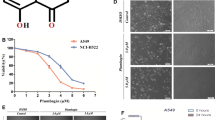Abstract
Cervical cancer is the most common cancer in Indian females and is associated with infection with high risk Human papillomaviruses (HPVs). Curcumin (Diferuloyl methane), a chemopreventive agent, is a natural compound extracted from Curcuma longa that allows suppression of carcinogenesis. The objective of this study was to identify the molecular mechanism of curcumin induced apoptosis in HPV positive cervical cancer HeLa, SiHa and Ca Ski cells. Curcumin causes distinct inhibition of human telomerase reverse transcriptase (hTERT) the catalytic core of telomerase thereby reducing proliferation of cancer cells. Curcumin mediated apoptosis in these cells appears to be due to upregulation of proapoptotic Bax, AIF, release of cytochrome c and down regulation of antiapoptotic Bcl-2, Bcl-XL in HeLa and SiHa. This was accompanied by an increase in caspase-3 and -9 activity, suggesting the role of mitochondria in curcumin mediated apoptotic cell death. Curcumin acts as an anti-inflammatory and anti-proliferative agent by causing down regulation of COX-2, iNOS and cyclin D1 in all the three cell lines but to different extent.









Similar content being viewed by others
References
Duvoix A, Blasius R, Delhalle S, Shnekeinburger M, Diedrich M (2005) Chemopreventative and therapeutic effects of curcumin. Cancer Lett 223:181–190. doi:10.1016/j.canlet.2004.09.041
Thangapazam RL, Sharma A, Maheshwari RK (2006) Multiple molecular targets in chemoprevention by curcumin. AAPS J 8(3):E443–E449. doi:10.1208/aapsj080352
Aggarwal S, Ichikawa H, Takada Y, Sandur SK, Shishodia S, Aggarwal BB (2006) Curcumin (Diferuloyl methane) down regulates expression of cell proliferation, antiapoptotic and metastatic gene products through suppression of IkBα kinase and Akt activation. Mol Pharmacol 69(7):195–206
Goel A, Kunnumakkara AB, Aggarwal BB (2008) Curcumin as “curecumin” from kitchen to clinic. Biochem Pharmacol 75(4):787–809. doi:10.1016/j.bcp.2007.08.016
Siwak DA, Shishodia S, Aggarwal BB, Kurzrock R (2005) Curcumin induces antiproliferative and proapoptotic effect in melanoma cells are associated with suppression of IkB kinase and nuclear factor kB activity and are independent of the B-Raf/mitogen activated/extracellular signal regulated protein kinase pathway and the AKT pathway. Cancer 104:879–890. doi:10.1002/cncr.21216
Wells SI, Arnow BJ, Wise TM, Williams SS, Couget JA, Howley PM (2003) Transcriptome signature of irreversible senescence in human papilloma positive cervical cancer cells. Proc Natl Acad Sci USA 100(12):7093–7098. doi:10.1073/pnas.1232309100
Chakrabarti O, Krishna S (2003) Molecular interaction of “high risk” human papilloma viruses E6 and E7 oncoprotein; implication for tumor progression. J Biosci 28(3):337–348. doi:10.1007/BF02970152
Shay JW, Zou Y, Hiyoma E, Woodrig EW (2001) Telomerase and cancer. Hum Mol Genet 10(7):677–685. doi:10.1093/hmg/10.7.677
Jaio MU, Wei XL (2002) Telomere and telomerase in oncology. Cell Res 12(1):1–7. doi:10.1038/sj.cr.7290104
Singh M, Sharma H, Singh N (2007) Hydrogen peroxide induces apoptosis in HeLa cells through mitochondrial pathway. Mitochondrion 7:367–373. doi:10.1016/j.mito.2007.07.003
Khanna N, Sen S, Sharma H, Singh N (2003) S29 ribosomal protein induces apoptosis in H520 cells and sensitizes them to chemotherapy. Biochem Biophys Res Commun 304:26–35. doi:10.1016/S0006-291X(03)00532-1
Singh M, Singh N (2008) Induction of apoptosis in HPV 16 positive cervical cancer cell lines, Involvement of mitochondrial pathway. Mol Cell Biochem 310(1–2):57–65. doi:10.1007/s11010-007-9665-5
Divya CS, Pillai MR (2006) Antitumor action of curcumin involves downregulation of viral oncogenes, prevention of NFkB and AP1 translocation and modulation of apoptosis. Mol Carcinog 45:320–332. doi:10.1002/mc.20170
Shay JW, Wright WE (2006) Telomerase therapeutics for cancer; challenge and the new directions. Nat Rev Drug Discov 5:577–584. doi:10.1038/nrd2081
Ripple MO, Eastman A (2001) The importance of MEK to ERK signaling for breast cancer cell survival. Proc Am Assoc Cancer Res 42:673
Chen YR, Tan TH (2000) The c-Jun N-terminal kinase pathway and apoptotic signaling. Int J Oncol 16(4):651–662
Matthew S, Squires E, Hudson A, Howells L (2003) Relevance of mitogen activated protein kinase (MAPK) and phosphatidyl inositol-3-kinase/protein kinase B (P13K/PKB) pathway in induction of apoptosis by curcumin in breast cells. Biochem Pharmacol 65:361–376. doi:10.1016/S0006-2952(02)01517-4
Stacey DW (2003) Cyclin D1 serves as a cell regulatory switch in actively proliferating cells. Curr Opin Cell Biol 15(2):158–163. doi:10.1016/S0955-0674(03)00008-5
Alao JP (2007) The regulation of cyclin D1 degradation; role in cancer development and potential for therapeutic intervention. Mol Cancer 6:24. doi:10.1186/1476-4598-6-24
Hui R, Finnay GL, Carroll JS, Lee CS, Mugrove EA, Sutherland RL (2002) Constitutive overexpression of cyclin D1 but not cyclin E confers acute resistance to anti estrogens in T-47 D breast cancer cells. Cancer Res 62(23):6916–6923
Eilers M, Schirm S, Bishop JM (1991) The MYC protein activates transcription of the alpha-prothymosin gene. EMBO J 10:133–141
Mayer MP, Bukau B (2005) Hsp70 chaperones: cellular functions and molecular mechanism. Cell Mol Life Sci 62:670–684. doi:10.1007/s00018-004-4464-6
Brown JR, Dubois RN (2005) COX-2; molecular targets for cancer prevention. J Clin Oncol 23:2840–2855. doi:10.1200/JCO.2005.09.051
Kong G, Kong PJ, Yuh YJ, Lim SY, Yim SV, Chun W, Kim SS (2004) Curcumin suppresses lipopolysaccharide induced cyclooxygenase-2 expression by inhibiting activator protein 1 and NFkB binding in BV2 microglial cells. J Pharmacol Sci 94:325–328. doi:10.1254/jphs.94.325
Chen Q, Crosby M, Almasan A (2003) Redox regulation of apoptosis before and after cytochrome c release. Korean J Biol Sci 7(1):1–9
Lorenzo HK, Susin SA, Penninger J, Kroimer G (1999) Apoptosis inducing factor (AIF): a phylogenetically old, caspase independent effector of cell death. Cell Death Differ 6:516–524. doi:10.1038/sj.cdd.4400527
Gupta S (2003) Molecular signaling in death receptor and mitochondrial pathway of apoptosis. Int J Cancer 22:15–20
Moos PJ, Edes K, Mullally JE, Fitzpatrick FA (2004) Curcumin impairs tumor suppressor p53 function in colon cancer cells. Carcinogenesis 25(9):1611–1617. doi:10.1093/carcin/bgh163
Acknowledgement
This work was supported by a senior research fellowship from CSIR to Mayank Singh and partially by grant from DBT.
Author information
Authors and Affiliations
Corresponding author
Rights and permissions
About this article
Cite this article
Singh, M., Singh, N. Molecular mechanism of curcumin induced cytotoxicity in human cervical carcinoma cells. Mol Cell Biochem 325, 107–119 (2009). https://doi.org/10.1007/s11010-009-0025-5
Received:
Accepted:
Published:
Issue Date:
DOI: https://doi.org/10.1007/s11010-009-0025-5




